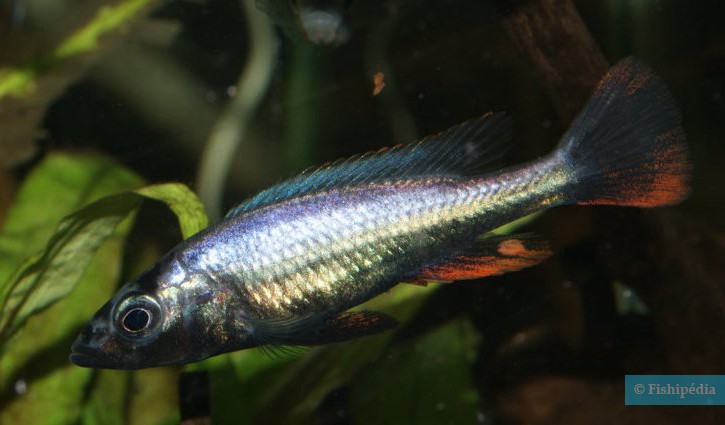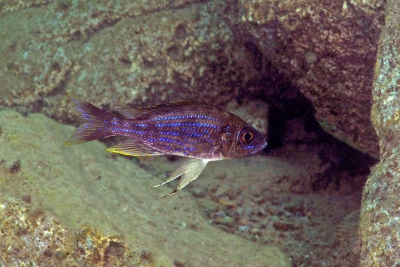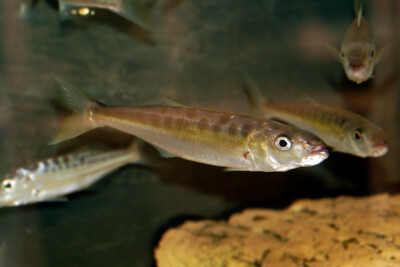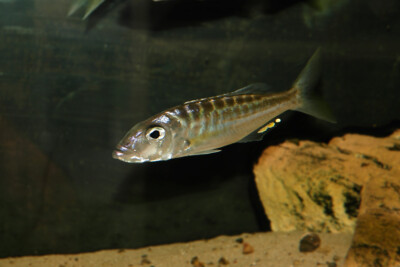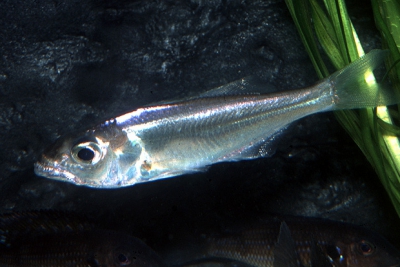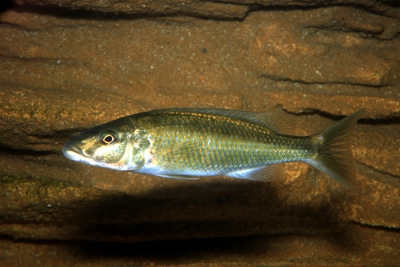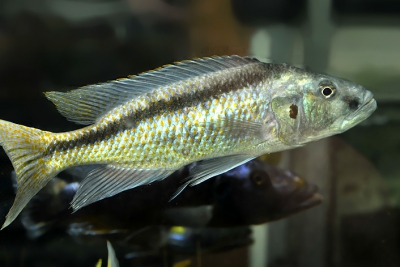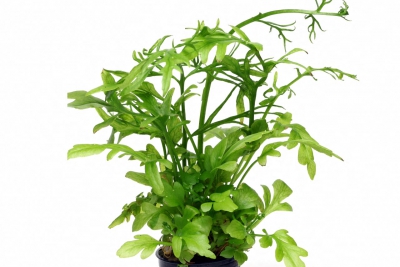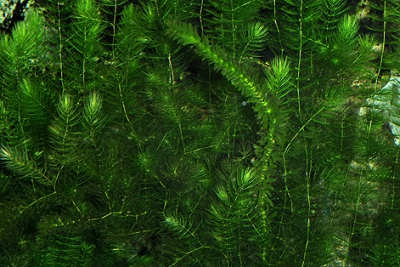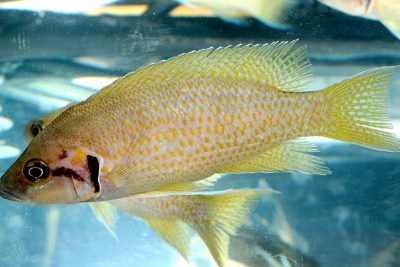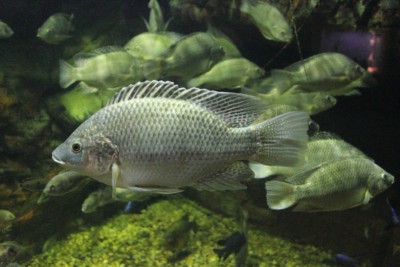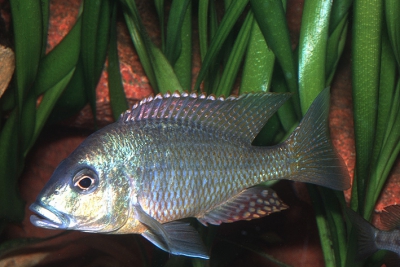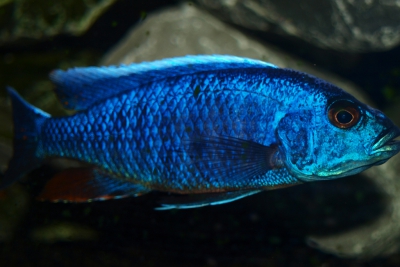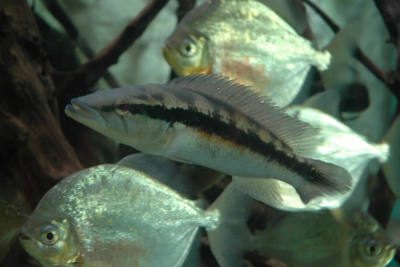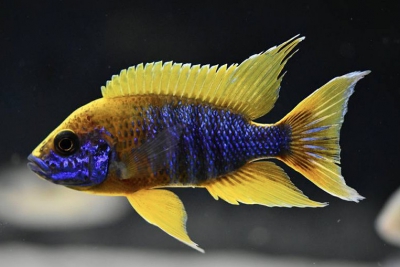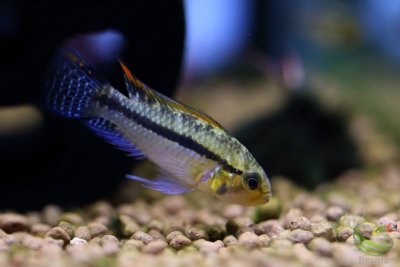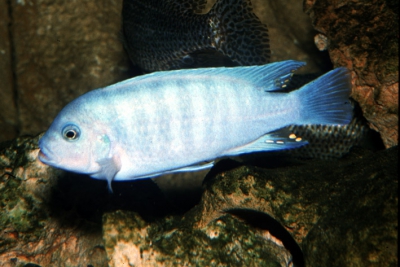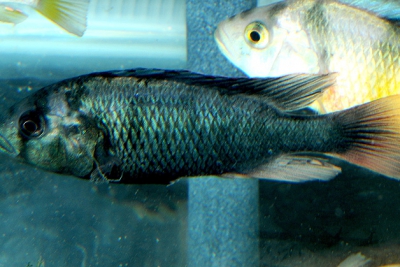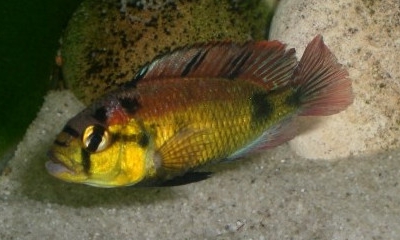double stripe
| Family | Cichlidae |
|---|---|
| Genus | Haplochromis |
| IUCN category (World) | VU |
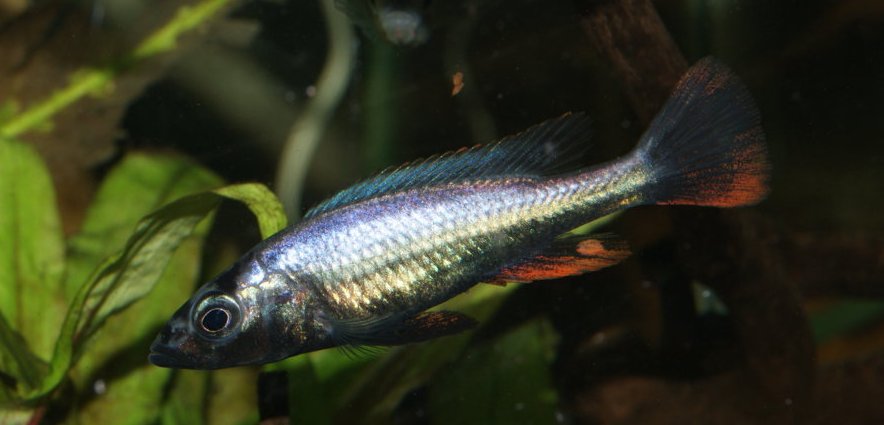

Introduction
Haplochromis thereuterion, commonly known as double stripe, is a fresh water fish from the Africa.
This sheet is currently being prepared. The texts currently proposed come from our data model or are being drafted. To request priority for this content, you can write to us HERE.
Who is it?
Morphology
-
Average size7 cm
-
Maximum size12 cm
-
Average size7 cm
-
Maximum size12 cm
How to recognize This fish ?
The double stripe measures between 7 and 12 cm.
Behaviour & Life cycle
-
dietcarnivorous
-
Sociabilityliving in small groups
-
territorialYes
-
Way of livingdiurnal
The double stripe is a fish living in small groups naturally found at mid-depth. The members of each group are organized around a well established hierarchy. This species is carnivorous .
Although slightly territorial, the double stripe is a rather peaceful animal that generally behaves in a peaceful manner with other species. Parades or even small jousts may occur between different members of the group until a hierarchy is established.
Reproduction
-
Reproductionovipare incubateur buccal
-
PolygamyYes
The double stripe is a fish ovipare incubateur buccal. In this species, the dominant males are polygamous and reproduce each season with several females.
Harmless species
This species does not represent any particular threats to humans when encountered in its natural environment.
Origin and distribution
Conservation status of populations (IUCN)
What is its habitat?
Natural environment characteristics
-
Temperature23 - 26 °C
-
pH (acidity)7.5 - 9
-
gh (hardness)2 - 3
-
FlowMedium
Biotope presentation
This animal evolves in areas characterized by a strong presence of vegetation (aquatic and marsh plants, decaying organic matter, roots...).
Main recommendations for fishkeeping
Deontology
In order to preserve wildlife, if you acquire this animal, it must not be released into the wild. See also, the Fishipedia charter.
Fishipedia supports the practice of responsible and environmentally friendly aquarium keeping. We encourage maintenance if it is motivated by a desire to understand the biological functioning of living things and if it is done with respect for animal life.
We believe that aquaristics is an opening to the discovery of aquatic environments, especially freshwater, and that this knowledge is necessary to better protect and respect these environments. Logically, we refute the compulsive purchase of animals that would not find a sufficient and / or adapted place in the host aquarium.
Our recommendations
-
Min volume300 liters
-
Population minnot specified
-
Temperature23 - 26 °C
-
pH (acidity)7.5 - 9
Characteristics
-
Difficulty breedingmoderate
-
Robustnesstolerant
-
Behaviourpeaceful
Recommended equipment from our partners
-
Aquarium
-
Filtration
General reminders
It is strongly advised to read the complete dedicated file and to get information on the feedbacks of maintenance of the envisaged animal, this to avoid any potential conflict whose end result is generally the death of the individual (or the other inhabitants). It is important not to overload your aquarium to limit pollution. This will make maintenance easier.
In nature, animals are subject to weather conditions and live in waters with variable characteristics. The recommendations offered by our team for aquarium maintenance are a guidance and cannot be assimilated to scientific datas.
General reminder on maintenance datas
Le démarrage d'un aquarium est une partie primordiale pour l'équilibre et le bien-être des poissons. Lorsque l'on met en eau un aquarium, l'eau passe naturellement par un cycle biologique : le cycle de l'azote. Celui-ci dure environ trois semaines. Tous les 2 jours, nous vous conseillons de tester votre eau jusqu'à ce que le taux de nitrite soit à zéro pendant plusieurs jours d'affilée.
Pour accélérer ce cycle, vous pouvez utiliser un activateur de bactéries comme JBL Denitrol. Cette solution riche en bactéries vivantes et enzymes permet une mise en place rapide du cycle de l'azote. Les poissons peuvent alors être introduits plus rapidement.
Il est important de tester l'eau de son aquarium régulièrement pour maintenir un environnement sain pour les poissons et les autres habitants. Les tests d'eau permettent de mesurer les niveaux de différents paramètres tels que le pH, la dureté totale, ainsi que les taux de nitrates, de nitrites et d'ammoniaque.
Pour réaliser ces tests, vous pouvez utiliser des produits d'analyse spécialisés tels que JBL ProScan qui permet de réaliser un diagnostic de l'eau directement via un smartphone. Il existe également des coffrets de tests plus classiques de bandelettes, comme JBL PROAQUATEST.
En cas d’usage de l’eau du robinet, vous pouvez utiliser un conditionneur d’eau de type Biotopol de JBL pour éliminer les substances nocives comme le chlore, le cuivre, le plomb et le zinc. Une eau trop dure ou trop calcaire peut être inadaptée à de nombreuses espèces tropicales d’eau douce. Si nécessaire, vous pouvez la couper avec de l’eau osmosée ou de pluie filtrée afin d’obtenir une dureté plus adaptée aux besoins de vos poissons et de vos plantes. Les conditionneurs d'eau garantissent une meilleure santé aux poissons et une meilleure croissance des plantes.
Chlorine and chloramine are dangerous for the health of animals. Used to disinfect water, these agents are present in significant quantities in tap water. We recommend using an anti-chlorine agent every time you change the water. In addition to chlorine, treatments and medicines sold for aquarium use sometimes contain dangerous heavy metals in high doses.
Specific needs for the double stripe
The double stripe is a species which lives naturally at a temperature between 23 °C and 26 °C. Nitrate levels should remain below 50mg/L. To keep the water clean and unpolluted, plan on changing 20% to 30% of the water volume each month.
The breeding of this species is accessible on condition of being well informed about its needs in aquarium . Any cohabitants must be chosen with care to avoid the loss of animals.
Cohabitation & Environment
Being a living in small groups fish, it is advisable to install at least 0 individuals in an aquarium of 300 liters minimum (for 120 cm of frontage). Group maintenance is a prerequisite to ensure their well-being. Lonely individuals tend to quickly become stressed and become especially susceptible to disease.
Fearful by nature, it is advised not to let the double stripe cohabit with large territorial species or with too aggressive fish. It can easily evolve with territorial neighbors with a peaceful temperament or with non-territorial species.
Be careful to plan an adequate space for each territorial species. Each species should have a surface and a decor allowing it to juxtapose its territory with that of its neighbors.
This fish being polygamous, the male must always be maintained with several females. A ratio of three females to one male seems to be a good compromise for the constitution of the group.
Males have the particularity to be particularly oppressive with females. This behavior can tire the females to the point that it sometimes leads to their death. It is important to set up a planted aquarium with many refuges.
The species enjoys a particularly vegetation-rich environment. The addition of plants will provide many useful hiding places for resting. These areas are also conducive to possible breeding in the aquarium. Floating plants such as Salvinia can be added to recreate the subdued atmosphere characteristic of its living conditions in the wild.
Basic water maintenance
The double stripe naturally living in basic water, the presence of limestone rocks such as millstone or travertine will improve its environment. It is also advisable to add sand with a contribution of specific salts to stabilize the pH, to be gauged according to the hardness of the water used.Tips for feeding
The double stripe is carnivorous.
This species can eat dry food (flakes, pellets), fresh food and frozen food. To avoid deficiencies, it is recommended to vary the types of food.
Feed animals in moderation to maintain good water quality. Meals should be eaten within 2–3 minutes, served in several small portions rather than a single large ration.
Uneaten food quickly decomposes, releasing ammonia, nitrites, and nitrates, which disturb the aquarium’s biological balance.
Make sure each species can access food properly, slower or bottom-dwelling individuals may require targeted feeding.Reproduction protocol
-
Maintenance difficultymoderate
-
egg-laying protectionYes
Reproduction of this species in an aquarium is considered moderate. Ideally, it takes place at a temperature of around 25 ° C for a pH of 8 .
Hybridization risks
In general, it is advised not to mix several species of the same genus or different varieties of the same species, to avoid the risks of hybridization.
These animals might interest you
These plants might interest you
Plants play a crucial role in aquariums, both for their ability to filter water by absorbing excess nutrients and for their aesthetic contribution. They provide fish with natural hiding places, can serve as breeding sites, and generally help maintain the overall balance and optimal conditions of the aquarium. The selection presented here includes species from the same regions as the species described on this page, although they do not necessarily come from its exact natural biotope.
To go further
Sources & Contributions
Participation & Validation
The Fishipedia team and specialist contributors are committed to providing high-quality content. However, although the information comes from scientific sources or testimonials from specialists, the cards may contain inaccuracies.
Translation
Translation done with the valuable contribution of our translators, who make this information available to a wider audience. We sincerely thank them for their commitment.
Scientific partners
Species of the same family
Same genus
